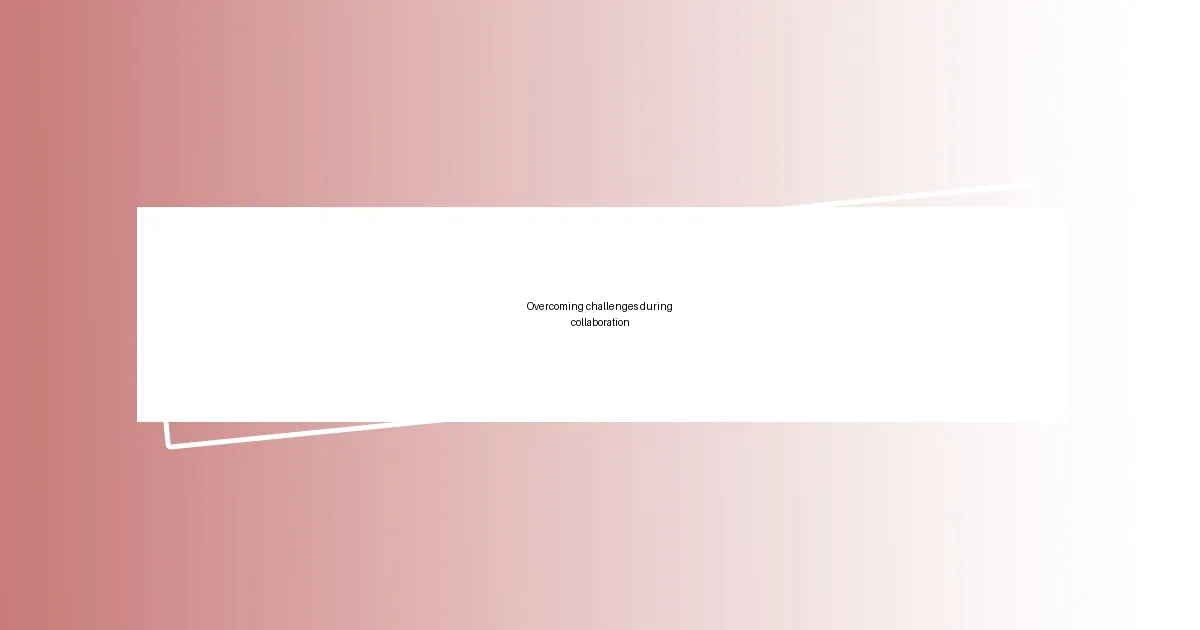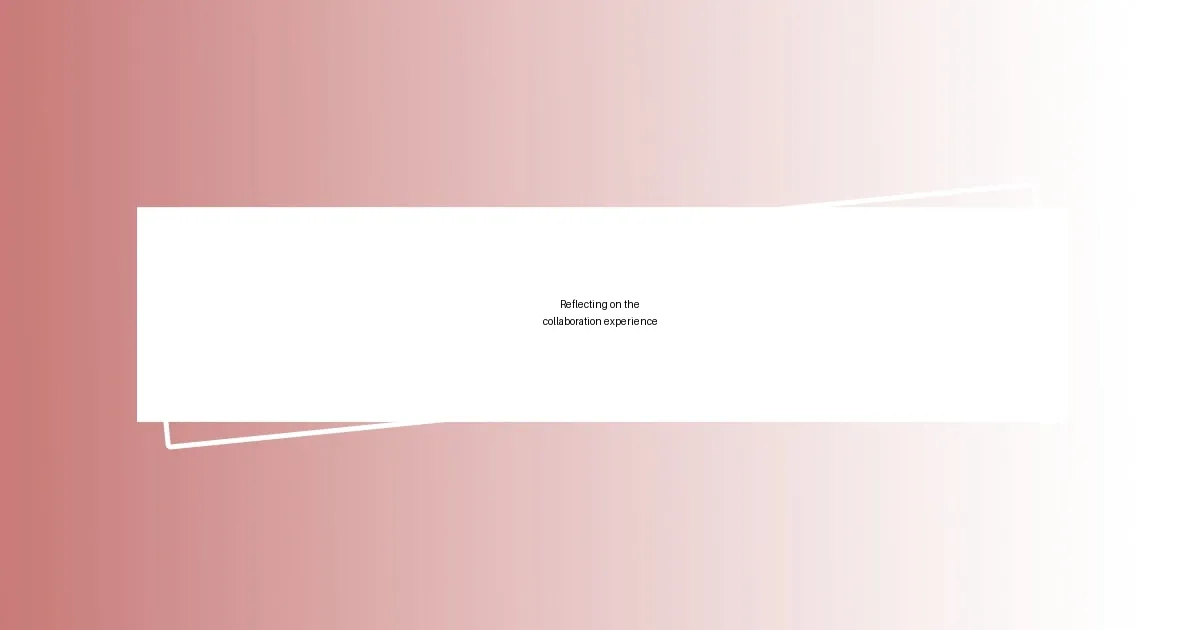Key takeaways:
- Collaboration amplifies creativity and fosters community, enabling artists to create impactful works together.
- Selecting the right collaborators based on shared vision, openness to experimentation, and interpersonal chemistry is crucial for successful projects.
- Establishing clear communication and setting shared goals enhances collaboration, ensuring all artists are aligned and motivated.
- Reflection on collaborative experiences aids personal and professional growth, highlighting the importance of both the process and the outcome.

My background in artist collaboration
In my early days as an artist, I remember my first collaboration vividly. I teamed up with a local painter, and together, we transformed an empty wall into a vibrant mural. The excitement of merging our styles taught me how collaboration not only amplifies creativity but fosters a sense of community.
Working with other artists has always been a rewarding journey. I’ve collaborated with musicians and dancers, each time learning to navigate different perspectives and practices. Have you ever thought about how powerful it feels to create something bigger than yourself? I know I have—every partnership helped me grow, both personally and professionally.
One of my most memorable collaborations happened at a music festival where I joined forces with a sculptor. We created an interactive piece that combined sound and sculpture. Witnessing our audiences engage with our work was exhilarating. It made me realize that artist collaboration isn’t just about combining talents; it’s about establishing a dialogue that resonates with others.

Key reasons for collaboration
Collaboration in the arts opens up a world of diverse perspectives that enrich the creative process. I’ve often found that when artists unite, the resulting synergy sparks ideas that would never emerge in isolation. One project I recall was a joint effort with a choreographer. The way we finessed movement with sound brought an organic flow that felt almost alive. It exemplified how teamwork can lead to innovative outcomes that might otherwise remain untapped.
Here are some key reasons why collaboration is so impactful:
- Diverse Perspectives: Each artist brings unique experiences and viewpoints, leading to richer, more complex works.
- Increased Creativity: Working alongside others can ignite fresh ideas, pushing boundaries that we may have subconsciously limited ourselves to.
- Community Building: Collaborations foster relationships, strengthening the creative community and promoting mutual support.
- Skill Development: Each partnership is an opportunity to learn new techniques, tools, and approaches from talented peers.
- Collective Impact: Together, artists can create larger, more evocative pieces that resonate deeply with audiences, amplifying the emotional reach of their work.

Selecting the right artists
Selecting the right artist for collaboration can profoundly impact the outcome of a project. I’ve learned that it’s vital to seek individuals whose styles and philosophies align with your own. For instance, during a project focused on community engagement, I partnered with a graphic designer who shared my passion for social issues. This shared vision not only enhanced our creativity but also made the process all the more fulfilling.
Another important aspect is the artists’ openness to experimentation. I recall working with a photographer who approached visual storytelling differently than I would have imagined. This collaboration pushed me to explore new techniques, blending our mediums uniquely. The joy in discovering new creative pathways together is something you can’t replicate alone.
Lastly, consider the interpersonal chemistry you share with potential collaborators. A memorable experience stood out for me when I first met a street artist. We had an instant rapport that translated seamlessly into our work. I believe that genuine connection makes it easier to communicate ideas, resolve conflicts, and ultimately, craft a piece that resonates deeply with both the creators and the audience.
| Criteria | Importance |
|---|---|
| Alignment of Vision | Ensures cohesive themes and objectives |
| Openness to Experimentation | Encourages creative risk-taking |
| Interpersonal Chemistry | Facilitates easy communication and collaboration |

Establishing clear communication channels
Establishing clear communication channels is essential in any collaborative project. I vividly remember a time when I was working on a mural with a fellow artist. Initially, we had a miscommunication about the color palette, which led to a lot of frustration. That experience taught me the importance of setting clear expectations right from the start. Using tools like shared documents or messaging apps can significantly enhance transparency. Have you ever faced similar challenges? I know I sure have, and it always reinforces just how vital open dialogue is.
In my view, regular check-ins can prevent misunderstandings and keep everyone aligned. During a recent project, we adopted a weekly virtual meeting that allowed us to share updates and voice concerns. It created a safe space where everyone felt heard, and our creativity flourished as a result. The ability to exchange ideas freely made it easier to adapt and pivot when necessary. It’s fascinating how a simple conversation can lead to breakthroughs in creativity.
Ultimately, the way we communicate shapes the whole collaborative process. I believe it’s beneficial to establish a mutual language that everyone understands, especially when different artistic languages are involved. During a project with a musician, we developed shorthand terms for various artistic elements. This not only sped up our discussions but also created a bond that transcended our distinct disciplines. Isn’t it incredible how effective communication can transform a creative partnership into a harmonious experience?

Setting shared goals and expectations
Setting shared goals and expectations is a cornerstone of fruitful collaboration. I remember diving into a project with a muralist where we initially sketched out our ideas together. We found common ground in our desire to evoke emotions tied to nostalgia. By clearly defining our shared goals, we aligned our creative energies, leading to a piece that truly resonated with our audience. How powerful is it to see your intentions manifest into art?
The journey of collaboration can sometimes feel overwhelming, especially when visions start to diverge. In one project, a planned music video took a turn when we realized our themes didn’t fully align. It was a wake-up call that led us to regroup and articulate our individual visions, merging them into a cohesive narrative. This experience taught me the importance of regularly revisiting our goals, ensuring we’re on the same page. Ever had to backtrack to gain clarity in a partnership? I certainly have, and it highlighted the beauty of adaptability in the creative process.
As artists, the act of creating often stems from personal passion and expression, but aligning on shared expectations can deepen that connection. I once collaborated on a workshop where we had to decide on the demographic we wanted to reach. By establishing clear expectations, every artist involved understood their role and contribution. This clarity transformed our individual motivations into a unified effort, which I found incredibly fulfilling. Have you ever experienced that moment when teamwork clicks and elevates the project? It’s an exhilarating feeling, isn’t it?

Overcoming challenges during collaboration
Working collaboratively can bring its own set of challenges, and I’ve found flexibility is key. During one project, my co-artist and I encountered differing interpretations of our central theme. Instead of allowing frustration to bubble, we decided to take a step back and engage in a brainstorming session, which led us to unexpected creative pathways. Has there ever been a moment where embracing a different perspective brought clarity to your work? It certainly did for us, revealing how staying open can transform an impasse into an opportunity.
Another significant hurdle in collaboration is balancing varied work styles and motivations. I recall a moment when deadlines were looming, and my collaborator and I were on different pages in terms of urgency. Rather than allowing tension to grow, we organized a casual coffee chat to reassess our timelines together. This simple gesture not only recalibrated our focus but fostered a deeper understanding of each other’s creative rhythms. I often wonder—how many conflicts could be avoided if we just took the time to understand where our teammates are coming from?
Resource management can also pose challenges in collaboration. Early in my career, I was part of a group project that initially had limited funding and resources. Instead of seeing this as a limitation, we reframed our approach by leveraging our unique skills and materials we already had. By thinking outside the box, we managed to create impactful work while pushing our creative boundaries. Have you ever found strength in adversity like that? It’s moments like these that reinforce my belief that challenges can lead to incredible innovation when tackled together.

Reflecting on the collaboration experience
Reflecting on the collaboration experience often brings a mix of emotions—joy, frustration, and ultimately, growth. One time, after completing a large mural, I stood back to admire our work and felt overwhelmed with pride. It was a surreal moment when I realized the incredible synergy we had created. Have you ever felt a rush of satisfaction in seeing collective efforts come to life? I definitely have, and it’s a feeling that lingers long after the project is complete.
Sometimes, the reflections after a project can lead to unexpected revelations. I once worked on a short film, and while I loved the final cut, I found myself pondering the missed opportunities for deeper storytelling. The collaborative feedback sessions had been a blast, yet I wondered if we could have pushed ourselves further. This introspection made me realize that sharing our insights post-project can enhance future collaborations. Have you ever caught yourself analyzing a project well after it’s done? It’s a fascinating way to grow, don’t you think?
In the end, every collaboration leaves a mark on me, shaping not just my art but also my perspective on teamwork. I recall a group installation where we faced numerous setbacks, but the shared laughter and late-night brainstorming sessions created unbreakable bonds. That experience taught me that reflection is not merely about assessing the outcome, but about appreciating the journey. Isn’t it enriching to look back and see how every project contributes to our personal and professional evolution?














